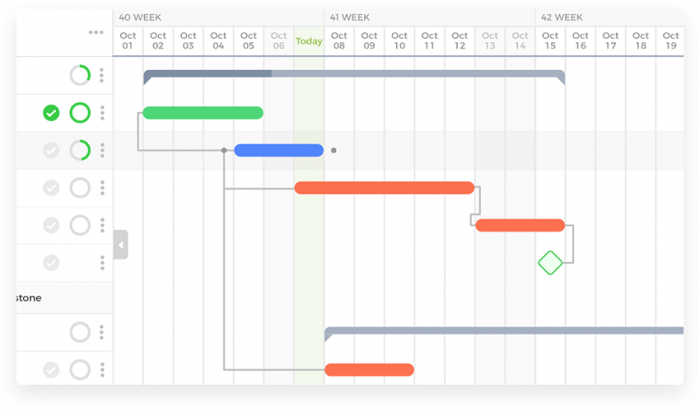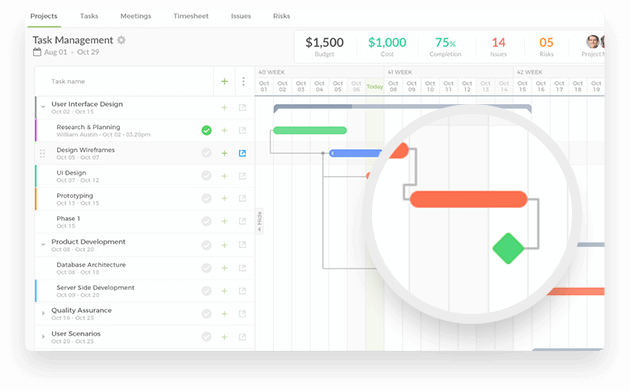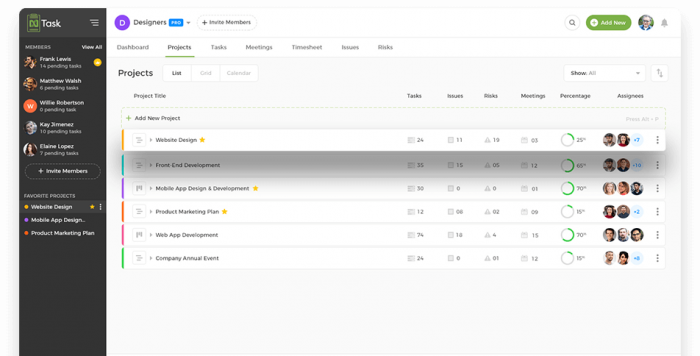Schedule management is one of the most important qualities that define a project manager’s brilliance.
This management is very important for the project as the success of every task and process connected to the project has to be completed according to schedule, otherwise, the customer is not going to trust the company again for their business.
These tasks and processes can include various elements like the deliverables, milestones, resources, timetables, and even risks connected to the project that have to be tracked according to schedule otherwise they can critically damage the project and cripple the company.
So, in this article, we are going to talk about what a schedule is; how you can manage it in the most brilliant ways, and how using project management software or a schedule management application can help you achieve success in 2024.
What is Project Schedule?

A project schedule is a timeline set by the project manager so that the tasks and processes that are required to make the project a success, are completed in time and the company generates a profit.
This schedule consists of a list of the different milestones, goals, tasks, resources, and deliverables connected to the project.
The project schedule can come from a lot of different places in the project’s domain, but the best schedule is mapped out from the requirements that the stakeholders have set for the project.
If you are wondering when the project schedule is created then the answer is “the planning phase of the project”. This phase of the project is critical as a lot of different things that are crucial for the project development are discussed in it.
The importance of a project schedule in the planning phase is that it maps out the exact time and dates on which the different tasks and processes related to the project development process are going to take place.
What are the Benefits of Project Scheduling in Project Management?
Here are some of the benefits that you can achieve if you create an effective project schedule.
- The schedule, first and foremost, is going to assist you in tracking a report, the progress of the entire roster of tasks and process related to the project
- The schedule is open to every member of the team and even the stakeholders, which helps everyone to be on the same page regarding information about the task dependencies, tasks, and their deadlines
- The schedule also helps to highlight the risks, scope creeps, and issues related to the project like a lack of resources or lack of personnel, overall or for a specific task
- This schedule also helps to highlight the task dependencies and helps to map out a way for the manager to manage those tasks better, to spare resources from being misused or wasted
- It can be used to track risks and scope creeps, but an amazing thing about schedule management is that it can track the risks and issues from the very beginning and helps in risk management for the project
Let’s take a look at how you can successfully create an effective Project Schedule.
Strategy to Create an Effective Project Schedule
Project schedules can be created with a lot of different inputs like the project requirements from the stakeholders or from studying the previous projects from the project’s domain, but the most effective way to create a schedule is to use the 5 W’s of Journalism.
This is a list of questions about the project that you ask yourself, and when you are done answering those questions, you will have a project schedule that you can use. Here are the 5 W’s.
- The first W is “Who”. This is where you ask yourself about the people that are going to be working on the project development process. Who is going to perform that task and who is going to perform that task. You do this because the different team members have their own pace of performing their work and you need to have a schedule in place, which is easy to be followed by everyone seamlessly.
- The second W is “What”. This is where you ask yourself about the resources and the personnel that you need to make the project happen. When you have gathered the resources, the infrastructure, and the personnel, you will have an idea to better craft your schedule.
- The third W is “Where”. Where is the project development process going to take place? This can involve the type of office space that the development process is going to use and the departments that are going to be included in the project development process.
- The fourth W is “When”. Now we are going to talk about the W which is very closely related to project schedule management. When is this task or that task going to happen? You will track the time it will take for your team to complete their tasks and officially nail down a timetable for the team so that if they steer away from the true path, they can check the timetable and get back on track.
- The last W is “Why”. This is where you answer a very important question regarding the project which is, Why are you developing the project? What is the ultimate goal of the project and what problem are you trying to solve by developing the project? When you pinpoint the ultimate goal that you are trying to achieve, you make it visible to the team members.
So, that when they get demoralized during the development process of the project, they will look at the goal and they will realize why they are fighting for, and their productivity will increase.
You don’t have to answer these questions alone, you can ask for the input of the stakeholders that are involved in the process and from the team members that are going to be involved in the project development process.
This helps to take the pressure off of the manager and they get some valuable input to manage the schedule from all the other key players involved in the project.
Let’s now talk about the 7 amazing ways you can spruce up your schedule management process and achieve success.
7 Amazing Ways to Better Manage Your Project Schedule
You have created a project schedule by using the upper mentioned strategy or any other strategy, but what happens next? The next step after that is to monitor and manage the schedule that you created.
But managing a schedule is a complex task and it requires the proper skill, strategy, calculation, time, and collaboration among the managers, team members, and the stakeholders connected to the project.
To help you with managing your project schedule, here are 7 amazing ways that will help you achieve success. They are:
1. Involve the Team Members and the Stakeholders in Your Schedule Management Process

As a project manager, we always tend to shy away from delegating any sort of responsibility to anyone else. This is a good thing in some cases but most of the time, we need someone whose input can help us in performing our role better.
In the case of schedule management, the input from the team members and the stakeholders is welcome because the team members are the people affected most by the schedule, as they have to adhere to it.
That’s why it’s a very good idea to involve them in the schedule creation and management process, so that they can let the manager know that the schedule is good for them or not. Why? Well, gone are the days when the manager would say something and the team members had to follow that, no matter what.
This strategy only resulted in decreased productivity and team members being exhausted.
This is why it’s great to include the team members and the stakeholders in the schedule management process so that you get a realistic schedule to manage that can be followed easily by the team.
2. Identify and Manage the Task Dependencies

Task dependencies are very important in program and project management. It is the relationship between different tasks amongst themselves.
To manage your schedule efficiently, you need to track down these task dependencies at the start of the project and make sure that the team knows about them.
This will keep them informed about what tasks they have to perform first and what tasks they have to perform after those tasks so that the project development process doesn’t get stuck in the future and you waste valuable resources.
One other thing that you have to keep an eye out for is that many times in the organizational paradigm, task dependencies just pop up out of nowhere and it’s your job as the project manager to incorporate them in the project development process, otherwise you are going to fail.
3. Identify the Critical Path of the Project Development Process

As a manager, it is your job to find out the critical path of the project development process in the planning phase.
This is very important as the critical path is the longest path that the development process can take and if you have mapped it out in the beginning, your team can find shorter ways to complete the project development process according to the schedule in time.
This is a big help in the overall project schedule management process.
4. List Down the Milestones

As a manager, you need to make a list of the milestones that you are trying to achieve through the project development process.
These milestones are used to mark the start and end of the project and it is a good strategy to list them down in the beginning so that you can create and manage the schedule around them.
5. Estimate the Time it Takes to Complete the Project

As a manager, you need to make sure that you have an idea of all of the tasks and processes connected to the project. This will help you get an idea of how they are going to be developed, and the start and end time of the whole development process.
This ultimately helps to manage the schedule that you developed and achieve success.
6. Identify the Scheduling Constraints
This is probably one of the most important steps that you have to take so that your scheduling management process can go well.
As a manager, you need to identify all of the constraints that are connected to the management of your schedule.
As a rule, these constraints are identified by the following elements.
- Time
- Scope of the project
- Budget
Here are some examples of constraints and assumptions that can relate to your project.
- Assuming that the whole team is going to be on vacation on a particular date
- Assuming that the budget allocated for the project development process is going to deplete before the development process ends
- Assuming that the whole salary of the team members is going to be a certain amount
When you have enough of these assumptions and constraints mapped out, you can manage the schedule very easily.
Check this out:
A Brief Explanation of the Triple Constraint in Project Management
7. Using a Project Management and Scheduling software

For all your scheduling and overall project management activities, you need to use software that can help you be successful every time. Try nTask. It is an amazing software that has incredible task management and time tracking features that can help you manage your schedule seamlessly.

-
Use The Best Schedule Management app, nTask
Manage all your tasks, projects, meetings, timesheets and more in one place. Sign up today!
- Get Started for Free
Over to you!
With that said, now it’s your turn to apply these schedule management tips to make your projects a success and help meet project deadlines.

